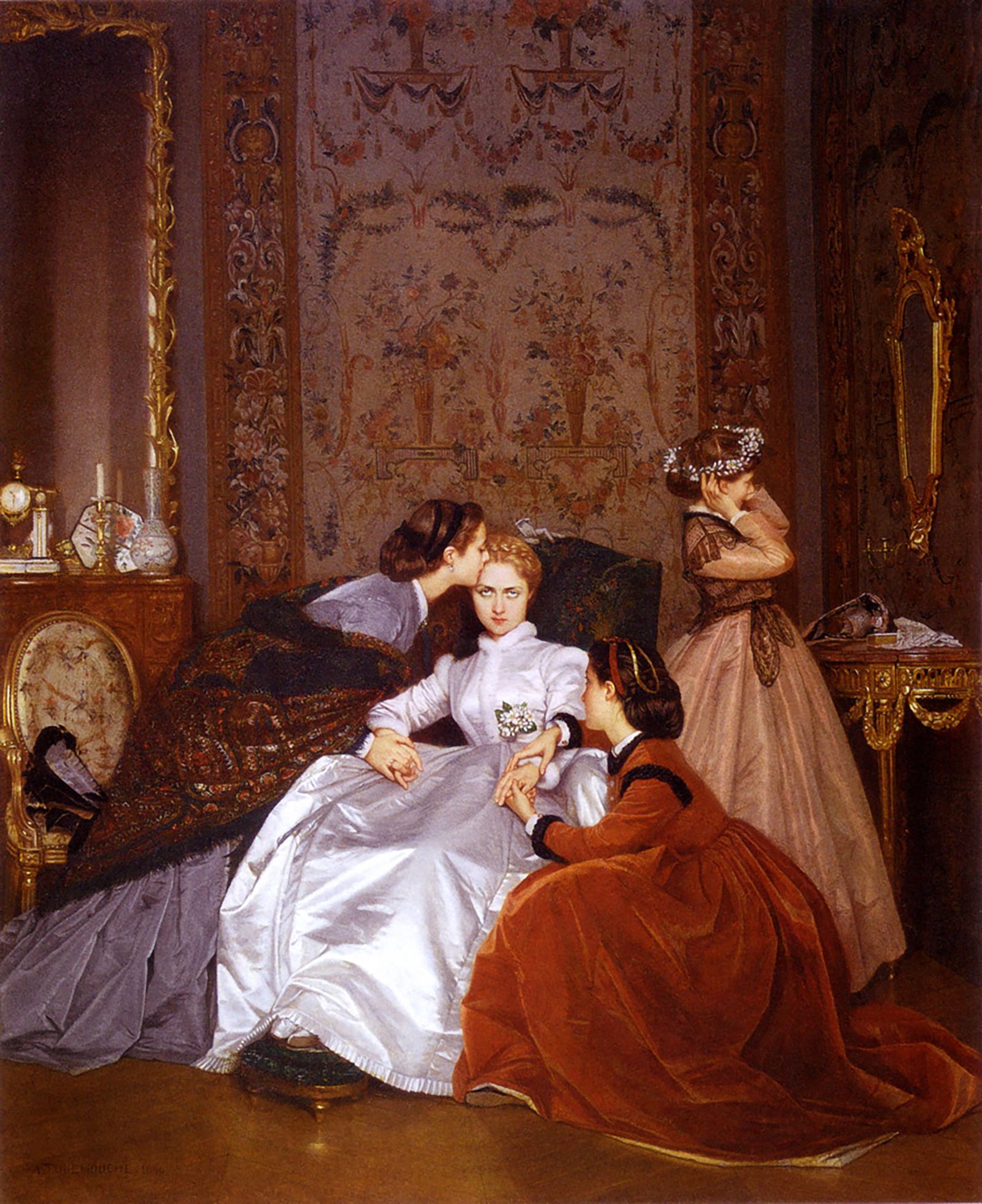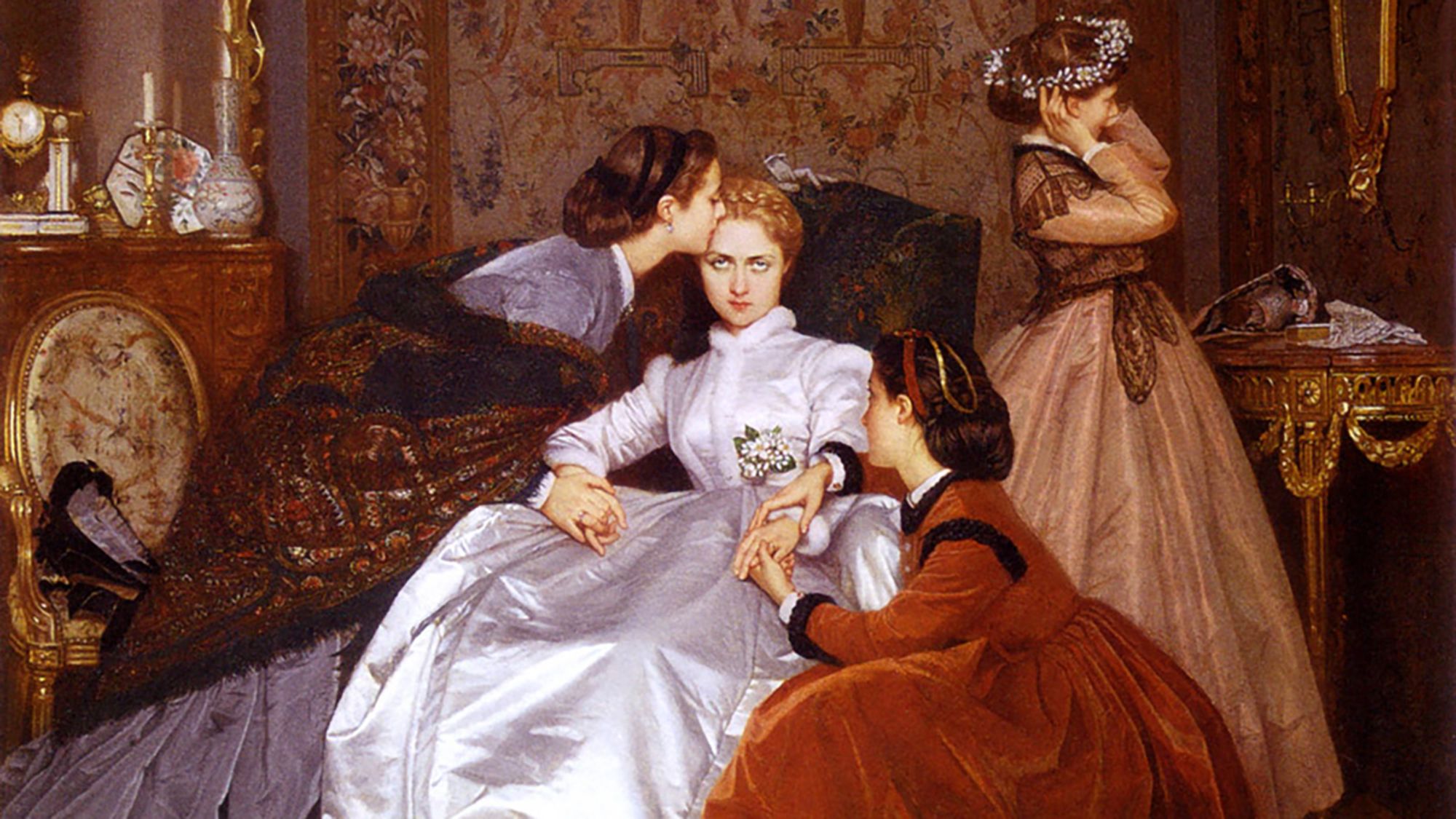Behold, a woman fuming.
Though she’s dressed in an opulent, fur-trimmed gown in a palatial French home sometime in the mid-19th century, her silent fury is recognizable to women the world over who’ve contained their ire to an eye roll.
She’s “The Hesitant Fiancée,” the eponymous subject of the painter Auguste Toulmouche’s 1866 painting. The realist work, which had been overshadowed in art history by the arrival of French Impressionist painters soon after, is being reappraised more than 150 years later by art buffs on TikTok.
She’s inspired scores of interpretations from users who imagine the undoubtedly irritated thoughts going through her mind when she was painted — “you’d look so much prettier with a smile on your face” — becoming something of a meme template. She’s appreciated by women who share her disillusionment with confining gender roles. And she’s inviting feminist reassessments of the painting itself.
When “The Hesitant Fiancée” was first exhibited, works depicting the quiet indignation of women were sometimes seen as unserious, and much of the popular art at the time satirized single women, said Kathryn Brown, associate professor of art history and visual culture at Loughborough University in the UK.
But seen through contemporary eyes, “The Hesitant Fiancée” shows women in solidarity, supporting each other in “negotiating oppressive systems,” noted Brown, who wrote about Toulmouche’s work in the monograph “Women Readers in French Painting 1870–1890.”
“Over a century and a half later, perhaps we’re still discovering the full political significance of that kind of unity,” she said in an email.
Toulmouche wasn’t a feminist painter, but his work speaks to women today
Toulmouche painted scenes of elegant, wealthy French women in domestic settings, often chronicling their romantic exploits. The women in his paintings were, on the surface, little more than sumptuously dressed debutantes — the French novelist Émile Zola in 1874 called Toulmouche’s subjects “delicious dolls,” Brown said.
Toulmouche’s paintings were successful in their day partly because of the “fantasy of female life” they depicted: The women in his works are wives, mothers, sisters and daughters who don’t stray from their roles in the domestic sphere, Brown said.
“The Hesitant Fiancée,” also translated to “The Reluctant Bride,” was originally exhibited under the title “Un mariage de raison,” or “A Marriage of Convenience” at the Académie des Beaux-Arts’ Paris Salon in 1866, Brown said. Toulmouche’s work was popular for a time, with his paintings often recreated as etchings in newspapers, Brown noted. But he was eventually overshadowed by Impressionist painters like Claude Monet and Edgar Degas, she said.

While Toulmouche was “by no means a painter of feminist art,” Brown said, the women in his paintings are interpreted today as slyly subversive.
In the 1865 painting “Forbidden Fruit,” three young women excitedly pore over books in a library while a fourth appears to guard the door. They’ve snuck into this room searching for information — “undoubtedly about sex,” Brown added, based on their wry smiles — that’s been kept from them.
Brown suggests that the four women in “Forbidden Fruit” reappear in “The Hesitant Fiancée,” now supporting one of their own in her unhappy slog toward the altar.
“One of the four young women from ‘Forbidden Fruit’ is now about to be married, perhaps to the ‘wrong’ person or because she doesn’t want to marry at all,” Brown said. “Read as a narrative that unfolds across the two works, it looks like the young woman from ‘Forbidden Fruit’ knows what’s about to happen to her.”
‘The Hesitant Fiancée’ is courting TikTok fans
The revival of “The Hesitant Fiancée” has been centuries in the making. Popular art accounts on TikTok started posting about it over the last few weeks, discovering it with glee, though at least one user, art enthusiast Kira (@TheArtRevival), shared a video about Toulmouche in February. She said in an email that she’s long loved his work.
“One of my favorite subjects in art is fancy ladies lounging around, living life with apathy,” she said. “Few can relate to their lives but nearly all can relate to their disdain.”
The popular user Tatyana About Art said that “The Hesitant Fiancée” is really a tragedy. The subject of the painting is likely depicted moments away from — or moments after — marrying the husband she’s less than in love with. She’s flanked by two women who gently attempt to comfort her while another plays with a flower crown in the mirror, perhaps dreaming of her own wedding day.
“The bride is completely alone in her sentiment of doom and unwillingness,” art historian Tatyana said in a video about “The Hesitant Fiancée.”
Today, though, some TikTok-ers view the titular fiancée as a rebel, not entering quietly into a marriage she’s unhappy about. Some users have theorized that she may not have been attracted to men at all, and since homosexuality was still viewed as immoral in 19th-century France, living openly would’ve been near-impossible at the time.
While we may never know the full story of the woman skulking in the armchair, her fed-up mien is familiar to anyone who’s ever had to swallow their anger. She’s trapped, said Kira, and “we’ve all been there.” That she’s expressing it within the confines of her rigid societal role is still captivating over a century later.
“I see her and think, ‘Yes babe, roll those eyes,’” Kira said.
